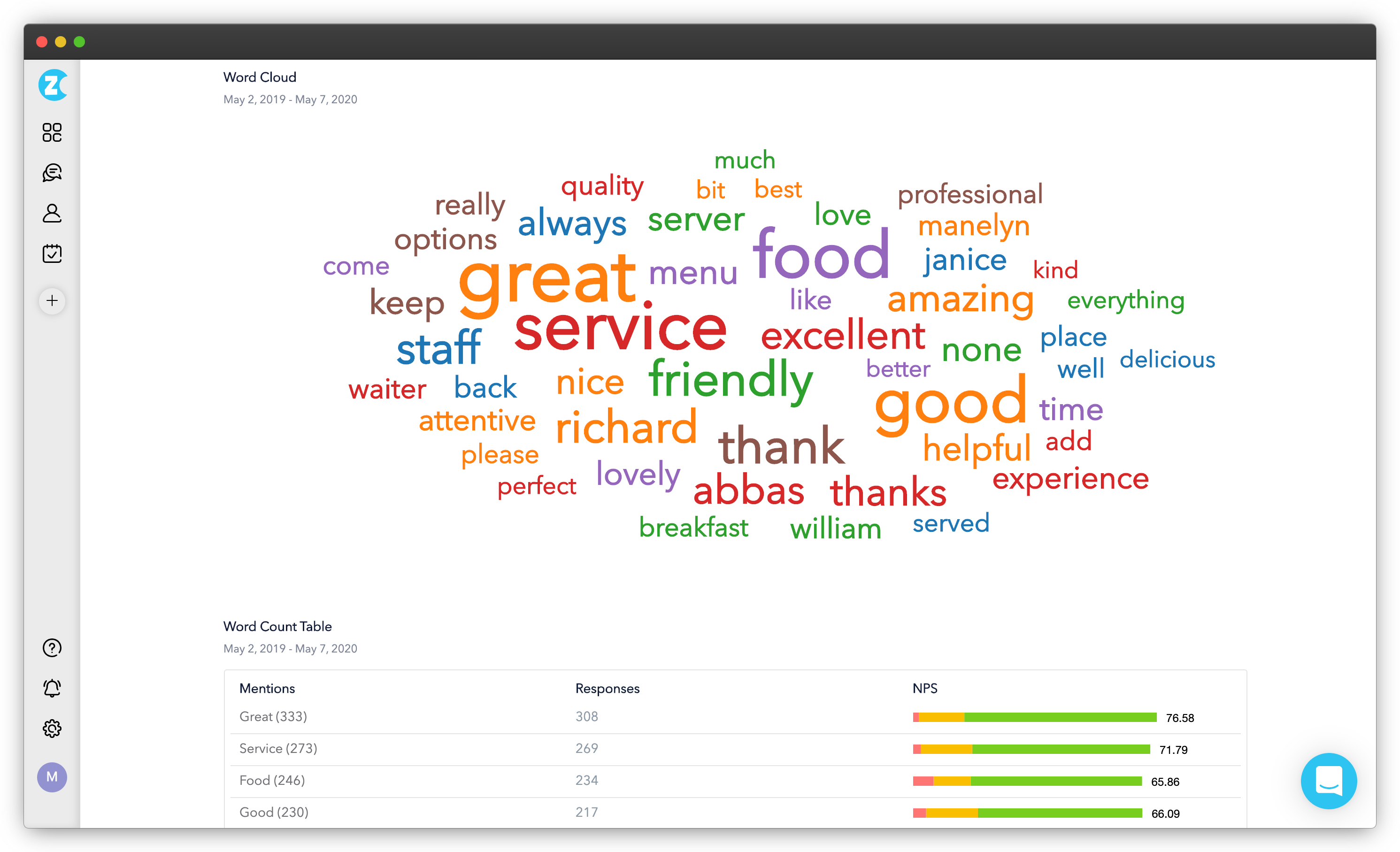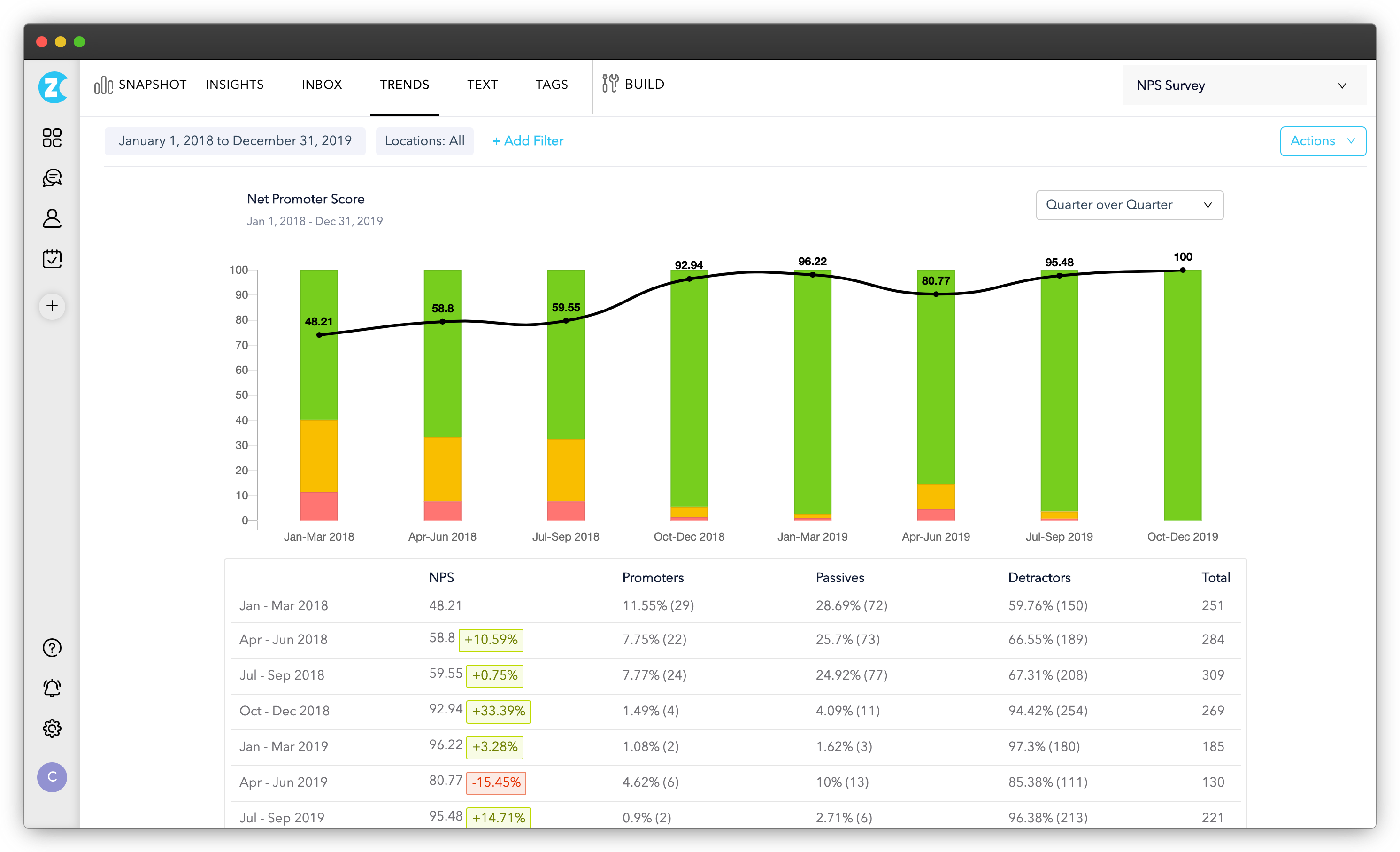Net Promoter Score® is often considered as a measurement of growth in an organization, and rightly so. But does the Net Promoter Score® alone show you your company's exact position and reputation in the market? Certainly not. Just looking at the score tells you how well (or not) you're doing in the business, but NPS® is undoubtedly more than just the numeric value.
While evaluating NPS® and looking at NPS Dashboards and Reports, you get a lot of rich data that you can effectively use to grow your business. The key is to use this NPS Data Analysis and Reporting intelligently to maximize its benefit.
We've put together some fantastic and super helpful tips for analyzing NPS Data and Reports for your business.
Tips for Effective NPS® Data Analysis and Reporting
Let's understand how these tips work for you to analyze your NPS data better.
Tip 1
Understand the NPS® Score and Analysis
The NPS can lie from -100 to 100. So if your NPS comes out to be negative, you have more detractors than promoters, whereas if your NPS is positive, you have more promoters than detractors. But it doesn't mean you can stay comfortable and don't need improvement.
Every single detractor can affect your goodwill and can harm your sales. So the question arises, what is a good Net Promoter Score? Well, NPS being good or bad depends upon the nature of your work and NPS in your industry. Still, you can take the below considerations while analyzing your NPS.
- If your NPS is below 0, it's a red signal for you, and you need a lot of improvement as you have many dissatisfied customers whom you should approach and try to improve their experience.
- If your NPS is 0, then the number of detractors and promoters is the same. But you still need to focus on your detractors and improve their Customer Experience because detractors are usually louder than promoters.
- If you have a positive score, and it lies between 0-30, you can consider it suitable as per global standards, yet there is a scope for improvement.
- If your NPS lies between 30-70, you are doing a good job, thus earning many loyal customers.
- If your NPS is above 70, it means that you are doing excellent business and your most customers are delighted with your work and are loyal to your brand.
Tip 2
Analyze the NPS® Distribution
For having an accurate picture of the position of your business, you need to analyze the NPS distribution, which means you should look into the number of your promoters, detractors, and passives individually, especially when you have multiple locations or branches for operating your business.
If you have multiple branches with the same NPS score, that doesn't mean they will be having the same number of promoters, detractors, and passives. It can vary from one location to another. For example, let's say you have two branches with the same NPS 50.
For one branch, promoters can be more than the second, and in the second branch, the number of passives can be more, and the number of detractors may be less than the first branch.
So you need to consider these numbers individually and make business plans to deal with your customers accordingly. You may need to follow separate steps to improve Customer Experience at various locations to satisfy the maximum number of customers.
Tip 3
Filter by Demographics
Demographic details are a great way to categorize your customers and analyze the collected feedback data. Choices and preferences vary a lot as per the customers' demographic factors like age, gender, location, income, etc. This difference in choice and preferences affects their purchase decision and perceptions about certain aspects of a brand.
By analyzing the demography of your promoters, detractors, and passives, you get rich data about the likes and dislikes of the customers of different groups. For instance, the food delivery experience of the customers from a particular location may be lacking due to some common reasons like difficulty and time-consumption for your delivery staff to find addresses there.
A particular product feature may make the product more attractive and high selling among the young customers fetching you many young promoters. In contrast, a product without the same feature would be more comfortable for the aged customers. Therefore, you can utilize this valuable data to get an idea about the strengths and weaknesses of your business and make better business decisions.
Tip 4
Review the Comments & do a Text Analysis
The ratings given by the customers are the most important thing to measure the Net promoter Score. Still, the comments with these ratings can be more utilitarian for effective NPS analyzing and reporting.
It would be best if you never ignore the comments given by the customers. Be it positive or negative, these comments will always give you the real customer insights guiding you through your journey towards your goals. Advanced features of NPS Survey tools nowadays like Text Analysis can help you categorize your comments and send automated responses.
Tip 5
Identify Root Causes
By analyzing the customers' responses properly with the help of their ratings and comments, try to identify the root causes which made them respond the way they did. If you know the root cause of any issue, you will be able to resolve it quickly.
For instance, you are an IT company providing internet services to your customers, and you get an issue of bad internet. It will help if you look into the comments of the customers and customer history. Is there any new install done for these customers which have caused some problem in the receiving signals? Is it the lousy quality of wires that are causing damage to the connection? Or the installation process is not appropriately done by the newly hired technicians?
Analyze to find out the root cause of the customers' concerns and work on them to improve Customer Experience.
Tip 6
Detect NPS® Trends over time
Tracking the customers' survey responses from time to time is an excellent way to ensure that you are moving in the right direction. NPS is itself a great way to track Customer Feedback through a score. In addition, analyzing the trend of your NPS can help you judge your business actions and decisions.
One way to do this is to send Relationship NPS surveys, i.e., surveys after a regular interval of time like monthly surveys, quarterly surveys, half-yearly surveys, or annual surveys. Doing this will tell you whether your NPS is improving over time or you need to take more decisive and better actions to improve it.
Secondly, you can send Transactional NPS surveys. These surveys are sent just after a transaction or event or purchase or a visit by the customers. This survey will help you track the immediate customers' sentiments just after the experience.
In this way, you will be able to see the trends in your business and get to know the choices and preferences of the customers. For instance, you started a new service or added a new feature to your product. In this case, you should analyze the trend of NPS going up or down to know whether your action is successful or not.
Tip 7
Compare NPS® from different locations
If you are running a brand at various locations, analyze your NPS at different locations. Doing this analysis will help you know what customers of multiple areas like or dislike about your brand. Also, this will help you to track the performance of your employees at different locations.
Tip 8
Share NPS® with in-House Teams
Measuring and analyzing Customer Satisfaction through Net Promoter Score is not something to be done in isolation. It is always advisable to involve in-house teams as well in this process. Sharing and discussing your NPS analyses and reports with your in-house team members will help you improve employee performance.
If your NPS is improving, your employees will feel motivated. If it is by chance going down, you can urge your teams to look into how things went wrong and how they can be improved going forward. All this will help you in the strategic planning of your business and boost employee performance.
Tip 9
Evaluate the NPS® Survey Distribution Channel that works for you
NPS Survey Software nowadays help you to capture survey responses through multiple channels like email, SMS, online, tablets, kiosks, etc. So you should find out the medium that works best for you. What works best can also depend on factors like the demography of the customers.
For instance, if you are sending email surveys to a customer group having a large youth population, you must take care that the email surveys you send are mobile-friendly. Studies suggest that 88% of millenials use smartphones to check their emails.
Also, you can try different channels for sending surveys and then analyze the response rates to know which medium works best for you, and then select that channel for future surveys.
To Sum Up
Net Promoter Score is a numeric value representing your organization's performance and its position in the market. But it is not just a number! To make the best out of it, it's always best to analyze it profoundly and individually with promoters, passives, detractors, and the NPS standards of your industry.
If you want to improve on NPS, you should look into what customers think of your products and organization and how you can make their experience better each time.




